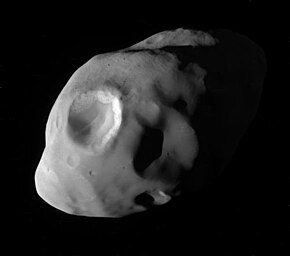
Back Pandora (maan) Afrikaans باندورا (قمر) Arabic پاندورا (قمر) AZB Пандора (спадарожнік) Byelorussian Пандора (спътник) Bulgarian Pandora (loarenn) Breton Pandora (satèl·lit) Catalan Pandora (ôi-sĭng) CDO Pandora (astrunumia) Corsican Pandora (měsíc) Czech
 View of Pandora's western hemisphere.[a] | |
| Discovery | |
|---|---|
| Discovered by | Stewart A. Collins D. Carlson Voyager 1 |
| Discovery date | October, 1980 |
| Designations | |
Designation | Saturn XVII |
| Pronunciation | /pænˈdɔːrə/ |
Named after | Πανδώρα Pandōra |
| Adjectives | Pandoran[1] |
| Orbital characteristics [2] | |
| Epoch December 31, 2003 (JD 2453005.5) | |
| 141720±10 km | |
| Eccentricity | 0.0042 |
| 0.628504213 d | |
| Inclination | 0.050°±0.004° to Saturn's equator |
| Satellite of | Saturn |
| Group | Possible outer shepherd moon of the F Ring |
| Physical characteristics | |
| Dimensions | 103.0 × 79.0 × 63.0 km (± 0.6 × 0.6 × 0.4 km)[3]: 2 |
| 80.0±0.6 km[3]: 2 | |
| Volume | 268990±860 km3[4]: 4 |
| Mass | (1.357±0.002)×1017 kg[b] |
Mean density | 0.5045±0.0017 g/cm3[4]: 4 |
| 0.0022–0.0061 m/s2[3]: 3 | |
| 0.019 km/s at longest axis to 0.024 km/s at poles | |
| synchronous | |
| zero | |
| Albedo | 0.6 |
| Temperature | ≈ 78 K |
Pandora is an inner satellite of Saturn. It was discovered in 1980 from photos taken by the Voyager 1 probe and was provisionally designated S/1980 S 26.[5] In late 1985, it was officially named after Pandora from Greek mythology.[6] It is also designated as Saturn XVII.[7]
Pandora was thought to be an outer shepherd satellite of the F Ring. However, recent studies indicate that it does not play such a role, and that only Prometheus, the inner shepherd, contributes to the confinement of the narrow ring.[8][9] It is more heavily cratered than nearby Prometheus and has at least two large craters 30 kilometres (19 mi) in diameter. The majority of craters on Pandora are shallow as a result of being filled with debris. Ridges and grooves are also present on the moon's surface.[10]
The orbit of Pandora appears to be chaotic as a consequence of a series of four 118:121 mean-motion resonances with Prometheus.[11] The most appreciable changes in their orbits occur approximately every 6.2 years,[2] when the periapsis of Pandora lines up with the apoapsis of Prometheus and the moons approach to within about 1,400 kilometres (870 mi). Pandora also has a 3:2 mean-motion resonance with Mimas.[2]
From its very low density and relatively high albedo, it seems likely that Pandora is a very porous icy body. However, there is much uncertainty in these values, so this remains to be confirmed.
Cite error: There are <ref group=lower-alpha> tags or {{efn}} templates on this page, but the references will not show without a {{reflist|group=lower-alpha}} template or {{notelist}} template (see the help page).
- ^ Robert Kolvoord (1990) Saturn's F ring: imaging and simulation, p. 104
- ^ a b c Spitale Jacobson et al. 2006.
- ^ a b c Thomas & Helfenstein 2020.
- ^ a b c Lainey et al. 2023.
- ^ IAUC 3532.
- ^ IAUC 4157.
- ^ USGS: Planet and Satellite Names and Discoverers.
- ^ Lakdawalla, E. (2014-07-05). "On the masses and motions of mini-moons: Pandora's not a "shepherd," but Prometheus still is". Planetary Society. Retrieved 2015-04-17.
- ^ Cuzzi, J. N.; Whizin, A. D.; Hogan, R. C.; Dobrovolskis, A. R.; Dones, L.; Showalter, M. R.; Colwell, J. E.; Scargle, J. D. (April 2014). "Saturn's F Ring core: Calm in the midst of chaos". Icarus. 232: 157–175. Bibcode:2014Icar..232..157C. doi:10.1016/j.icarus.2013.12.027. ISSN 0019-1035.
- ^ Solar System, NASA: Pandora.
- ^ Renner et al. 2005.
© MMXXIII Rich X Search. We shall prevail. All rights reserved. Rich X Search